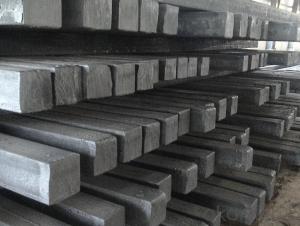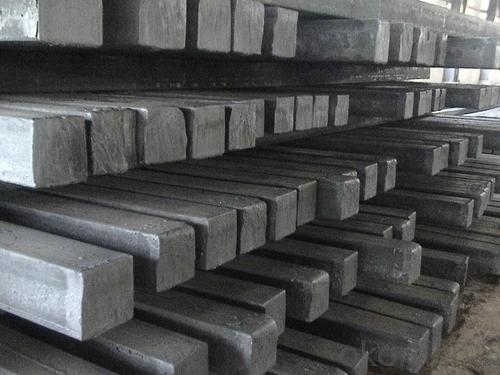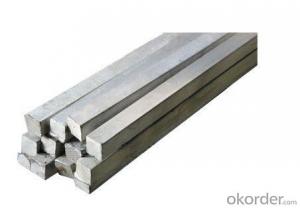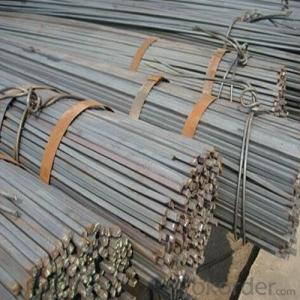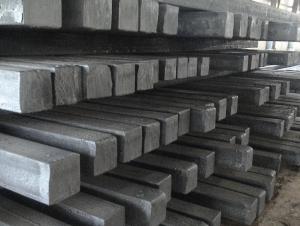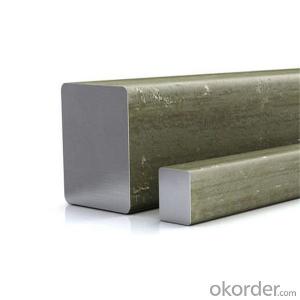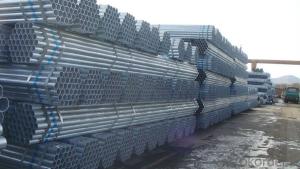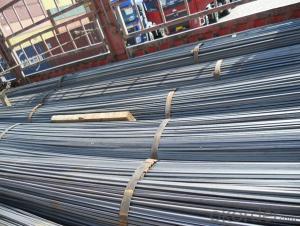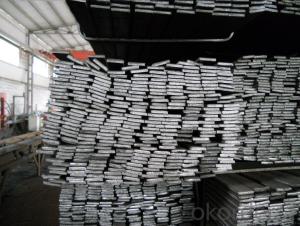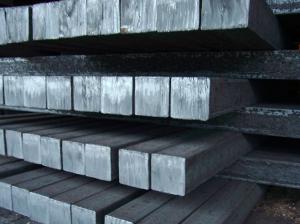hot rolled square steel billets
- Loading Port:
- China Main Port
- Payment Terms:
- TT OR LC
- Min Order Qty:
- -
- Supply Capability:
- -
OKorder Service Pledge
OKorder Financial Service
You Might Also Like
Product Description:
Packaging & Delivery
| Packaging Detail: | in bundles |
| Delivery Detail: | according to the quantity |
Specifications
square steel billet
1.3SP, 5SP
2.terms of payment: L/C at sight
3.size: 120*120mm
4.length: 5.8~12m
square steel billet
Specifications
square steel billets
1)We procure world class quality steel billets which meets the specific requirements of the clients
The Billets produced by the company can be broadly divided into three main types i.e.
M.S. Billets
CRS Billets
Special Alloy Billets
M.S. Billets are used for rolling of TMT Re-Bars of Fe415 and Fe500 Grade and various other structural steel products.
CRS Billets are used fro rolling of CRS TMT Re-Bars.
Special Alloy Billets are used for rolling of any special grade TMT Re-Bars like Earthquake resistant TMT Re-Bars and for special grade structural steel products.
The following are the sizes of Billets available with Shyam Steel Industries Ltd.:
100 X 100
120x120
150 X 150
Physical Properties:
Description | As per IS 2830 | Shyam Billets |
| Bend (max.) | 5 mm per meter | >= 5 mm per meter |
| Carbon (max.) | 3mm per meter | >= 3 mm per meter |
| Length | 3 mt - 13 mt | 3 mt - 9 mt |
Chemical Properties:
Ladle Analysis: | ||
Designation | Carbon | Manganese |
| C15 | 0.12-0.18 | 0.30-0.60 |
| C18 | 0.15-0.21 | 0.30-0.60 |
| C20 | 0.17-0.23 | 0.30-0.60 |
| C15 MMn | 0.12-0.18 | 0.60-1.00 |
| C18 MMn | 0.15-0.21 | 0.60-1.00 |
| C20 MMn | 0.17-0.23 | 0.60-1.00 |
| C15 HMn | 0.12-0.18 | 1.00-1.50 |
| C18 HMn | 0.15-0.21 | 1.00-1.50 |
C20 HMn | 0.17-0.23 | 1.00-1.50 |
Billets of different designations are manufactured in three different grades namely A, B, C having sulphur, phosphorous content (on ladle analysis) and carbon equivalent as follows:
| Chemical Analysis: | |||
| Grade | Sulphur | Phosphorous | Carbon Equivalent (CE)1 |
| Max | Max | Max | |
| A | 0.05 | 0.05 | 0.42 |
| B | 0.045 | 0.045 | 0.41 |
| C | 0.04 | 0.04 | 0.39 |
- Q: How do you use a steel square for creating accurate rabbet cuts?
- For achieving precise rabbet cuts, the following steps should be followed while utilizing a steel square: 1. Begin by measuring and marking the dimensions of the desired rabbet cut on the wooden surface, which includes both the width and depth of the rabbet. 2. Align one side of the steel square with the wooden edge, ensuring it is placed accurately on the wood. 3. While firmly holding the steel square in place with one hand, employ a pencil or marking knife to trace along the other side of the square. This will generate a straight and precise guideline for the rabbet cut. 4. Proceed to repeat this procedure on the adjacent side of the wood, employing the same measurement and aligning the square with the previously marked line. This will ensure parallelism and precision in the rabbet cut. 5. Utilize a chisel, router, or table saw to eliminate the material within the marked lines, following the straight guideline established by the steel square. It is crucial to take your time and make accurate cuts to accomplish a clean and precise rabbet. 6. Once the rabbet cut is completed, utilize the steel square once more to verify squareness and guarantee that the corners of the rabbet are at perfect right angles. By utilizing a steel square as a reference guide, accuracy and precision can be maintained in your rabbet cuts, ultimately resulting in well-executed and professional-looking woodworking projects.
- Q: Can a steel square be used for checking the squareness of picture hanging systems?
- Yes, a steel square can be used for checking the squareness of picture hanging systems. A steel square is a tool commonly used in carpentry and woodworking to ensure accuracy and squareness. It has a right angle shape and provides a reliable reference for measuring and checking squareness. By placing the steel square against the edges of the picture hanging system, you can determine if it is properly aligned and perpendicular to the wall.
- Q: How do you use a steel square to find angles for compound bevel miter cuts?
- To use a steel square to find angles for compound bevel miter cuts, you will follow a few steps. First, ensure that your steel square is clean and free from any debris. 1. Determine the desired angle for the compound bevel miter cut. This angle will depend on the specific project or design you are working on. 2. Place the steel square on the edge of the material that you want to make the cut on. Ensure that the square is aligned properly and firmly against the material's edge. 3. Locate the angle measurement on the steel square that corresponds to the desired angle for the cut. This measurement will usually be marked on the square. 4. Once you have located the measurement, use a pencil or marker to mark the material at the corresponding angle on the square. This mark will indicate where the cut should be made. 5. Repeat this process on any other edges or sides of the material that require the same angle for the compound bevel miter cut. 6. Once all the necessary marks are made, use a saw or appropriate cutting tool to carefully follow the marked lines and make the desired compound bevel miter cuts. It is important to note that using a steel square requires accuracy and precision. Double-check your measurements and marks before making any cuts to ensure the best results. Additionally, practice and experience will improve your ability to use a steel square effectively for compound bevel miter cuts.
- Q: How do you use a steel square to find angles for coping cuts?
- To use a steel square to find angles for coping cuts, you will need to follow these steps: 1. Start by identifying the angle you need to cut. This could be the angle of a corner or the angle of a miter joint, for example. 2. Place the steel square on the workpiece, aligning one side of the square with the edge of the material. 3. Rotate the square until the other side of the square aligns with the adjacent edge or surface. This will create a corner with the two edges of the material. 4. Once the square is properly aligned, use a pencil or a scribe to mark the angle on the workpiece. You can do this by drawing along the edge of the square. 5. Remove the square from the workpiece and extend the marked line as needed. 6. Finally, make the coping cut along the marked line using the appropriate tool, such as a coping saw or a jigsaw. Using a steel square to find angles for coping cuts allows you to accurately transfer the angle from one piece of material to another, ensuring a precise fit for your project. Remember to double-check your measurements and make any necessary adjustments before making the final cut.
- Q: Can a steel square be used for checking the squareness of a lathe tailstock?
- Certainly! A lathe tailstock's squareness can indeed be checked with a steel square. This precise measuring tool possesses a right angle, allowing it to effectively assess whether the tailstock is perpendicular to the lathe bed. Simply position the steel square against the base of the tailstock and the lathe bed to promptly detect any deviations from a right angle. This crucial procedure guarantees the precision of machining operations executed on the lathe.
- Q: How do you use a steel square to lay out a diagonal line on a curved surface?
- In order to lay out a diagonal line on a curved surface using a steel square, several steps need to be followed: 1. Begin by positioning the steel square on the curved surface, aligning one edge horizontally and the other vertically. Make sure the square is securely placed and doesn't shift. 2. Determine the starting point of the diagonal line on the curved surface. This can be any desired point along the curve. 3. Locate the desired diagonal measurement on the steel square. This measurement will determine the length and angle of the diagonal line to be laid out. 4. Align the chosen diagonal measurement on the vertical edge of the steel square with the starting point of the line on the curved surface. This point can be marked with a pencil or marker for reference. 5. Rotate the steel square along the curved surface while maintaining alignment between the vertical edge of the square and the marked starting point. As you rotate, the horizontal edge of the square will trace a diagonal line on the curved surface. 6. Keep rotating the square until you reach the desired endpoint of the diagonal line. The horizontal edge will continue to mark the line on the curved surface as you rotate. 7. Once the endpoint is reached, mark the line on the curved surface using a pencil or marker, following the path traced by the horizontal edge of the steel square. By following these steps, a diagonal line can be accurately laid out on a curved surface using a steel square. It is crucial to ensure the square remains firmly in place throughout the process to maintain precision.
- Q: Can a steel square be used for baseboard installation?
- Yes, a steel square can be used for baseboard installation. A steel square, also known as a framing square or a carpenter's square, is a versatile tool that is commonly used in woodworking and construction projects. It is a durable and sturdy tool made of steel, with a 90-degree angle and a ruler along the edge. When it comes to baseboard installation, a steel square can be extremely helpful. It can be used to ensure accurate and precise cuts on the baseboard material, as well as to mark and measure angles for corners and joints. The 90-degree angle of the steel square is particularly useful for marking and cutting baseboards that need to fit perfectly into corners or against walls. Additionally, a steel square can be used to check the levelness and squareness of the baseboards during the installation process. By placing the square against the baseboard and the wall, you can easily determine if the baseboard is straight and aligned correctly. Overall, while there are other tools available for baseboard installation, a steel square is a reliable and versatile option that can be used effectively in this task.
- Q: How do you use a steel square to determine the length of a retaining wall?
- To use a steel square to determine the length of a retaining wall, follow these steps: 1. Begin by finding a level surface where you can work comfortably. Place the steel square on this surface. 2. Position the steel square against the edge of the retaining wall, ensuring that it is flush and perpendicular to the wall. 3. Slide the steel square along the wall until it reaches the end. Make sure to keep it aligned with the wall edge throughout this process. 4. Once the steel square reaches the end of the wall, take note of the measurement on the steel square corresponding to the edge of the wall. This measurement will indicate the length of the retaining wall. 5. If the retaining wall is longer than the length of the steel square, repeat the process by aligning the square with the previous measurement and sliding it further along the wall until you reach the next section. Add up the measurements obtained from each section to determine the total length of the retaining wall. It's important to use a steel square that is in good condition and properly calibrated to ensure accurate measurements. Additionally, make sure to take into account any irregularities or curves in the wall when using the steel square for measurement.
- Q: How do you use a steel square to measure and mark chamfered angles?
- In order to measure and mark chamfered angles using a steel square, it is necessary to follow a series of steps. Begin by ensuring that your steel square is clean and devoid of any debris or rust. This will guarantee precise measurements and markings. Next, identify the specific angle at which you wish to create a chamfer. Typically, a chamfer is a 45-degree angle, but this may vary depending on your individual project. Position the steel square against the material's edge where you intend to create the chamfer. Align one side of the square with the material's edge and ensure it is securely in place and level. Once the square is positioned, use a pencil or marker to make a mark along the square's edge. This mark will create a straight line representing the chamfer's edge. To determine the length of the chamfer, measure the distance from the marked line to the desired endpoint of the chamfer. Obtain an accurate measurement using the steel square's ruler markings or a separate measuring tool, such as a tape measure. After determining the length, utilize the steel square to mark the endpoint of the chamfer. Align the square with the marked line and make another mark at the desired length. Lastly, connect the two marks to form the chamfered line. For a straight and precise line, use either the steel square or a straight edge. Prior to cutting or shaping the material, it is crucial to double-check your measurements and markings. It is advisable to practice on scrap material or make test cuts to ensure the accuracy of the chamfer before proceeding with your final project.
- Q: Can a steel square be used for checking the squareness of bookshelves?
- Yes, a steel square can be used for checking the squareness of bookshelves. A steel square is a versatile tool commonly used by carpenters and woodworkers to ensure precision and accuracy in their projects. Its straight edges and right angles make it ideal for checking the squareness of various objects, including bookshelves. To use a steel square, place one of its straight edges against the edge of the bookshelf and align the other edge perpendicular to it. This will allow you to determine if the shelf is perfectly square or if there are any discrepancies. By comparing the angles formed by the steel square with the corners of the bookshelf, you can identify any misalignments and make adjustments accordingly. Checking the squareness of bookshelves is important to ensure stability, proper alignment, and functionality. A square bookshelf will provide better support for the books and prevent them from leaning or falling. It will also ensure that the bookshelf fits properly in its designated space, avoiding any gaps or unevenness. Therefore, if you have a steel square on hand, it can be a valuable tool for checking the squareness of bookshelves and ensuring the quality and functionality of your furniture.
Send your message to us
hot rolled square steel billets
- Loading Port:
- China Main Port
- Payment Terms:
- TT OR LC
- Min Order Qty:
- -
- Supply Capability:
- -
OKorder Service Pledge
OKorder Financial Service
Similar products
Hot products
Hot Searches
Related keywords
